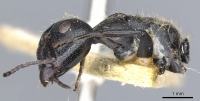Camponotus lamborni
| Camponotus lamborni | |
|---|---|

| |
| Scientific classification | |
| Kingdom: | Animalia |
| Phylum: | Arthropoda |
| Class: | Insecta |
| Order: | Hymenoptera |
| Family: | Formicidae |
| Subfamily: | Formicinae |
| Tribe: | Camponotini |
| Genus: | Camponotus |
| Species: | C. lamborni |
| Binomial name | |
| Camponotus lamborni Donisthorpe, 1933 | |
Identification
Distribution
Latitudinal Distribution Pattern
Latitudinal Range: -14.463253° to -14.463253°.
| North Temperate |
North Subtropical |
Tropical | South Subtropical |
South Temperate |
- Source: AntMaps
Distribution based on Regional Taxon Lists
Afrotropical Region: Malawi (type locality).
Distribution based on AntMaps
Distribution based on AntWeb specimens
Check data from AntWeb
Countries Occupied
| Number of countries occupied by this species based on AntWiki Regional Taxon Lists. In general, fewer countries occupied indicates a narrower range, while more countries indicates a more widespread species. |

|
Estimated Abundance
| Relative abundance based on number of AntMaps records per species (this species within the purple bar). Fewer records (to the left) indicates a less abundant/encountered species while more records (to the right) indicates more abundant/encountered species. |

|
Biology
Castes
Images from AntWeb

| |
| Holotype of Camponotus lamborni. Worker (major/soldier). Specimen code casent0903489. Photographer Will Ericson, uploaded by California Academy of Sciences. | Owned by NHMUK, London, UK. |
Nomenclature
The following information is derived from Barry Bolton's Online Catalogue of the Ants of the World.
- lamborni. Camponotus (Myrmotrema) lamborni Donisthorpe, 1933b: 196 (s.w.m.) MALAWI.
- Status as species: Bolton, 1995b: 107.
Description
References
References based on Global Ant Biodiversity Informatics
- Donisthorpe H. 1933. Descriptions of three new species of Formicidae, and a synonymical note. Annals and Magazine of Natural History (10)11: 194-198.

